Bioenergy Europe: Bioenergy in the EU in 2023
Bioenergy Europe publishes annually a statistical in-depth overview of the bioenergy sector in the EU-27 member states. A new Bioenergy Statistical Report for 2023 was published on December 5.
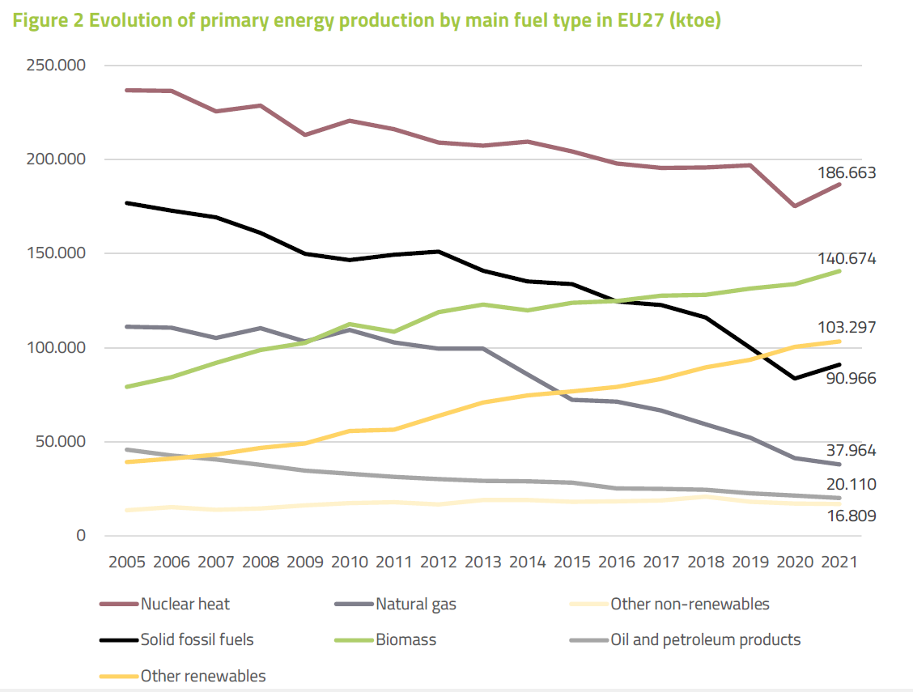
Biomass remains the most important local energy source in Europe. Larger volumes of energy are produced only by nuclear energy. Despite the fact that several EU member states have uranium deposits, its extraction is not carried out in the EU, as a result, Europe is significantly dependent on Kazakhstan, the world’s largest producer of uranium. Given that nuclear energy depends on the import of uranium, its positioning as a local source of energy remains debatable.
Renewable energy sources are developing steadily, which proves their stability and reliability. Today, we see that RES are crucial not only for reducing CO2 emissions in Europe, but also for strengthening the EU’s energy independence.
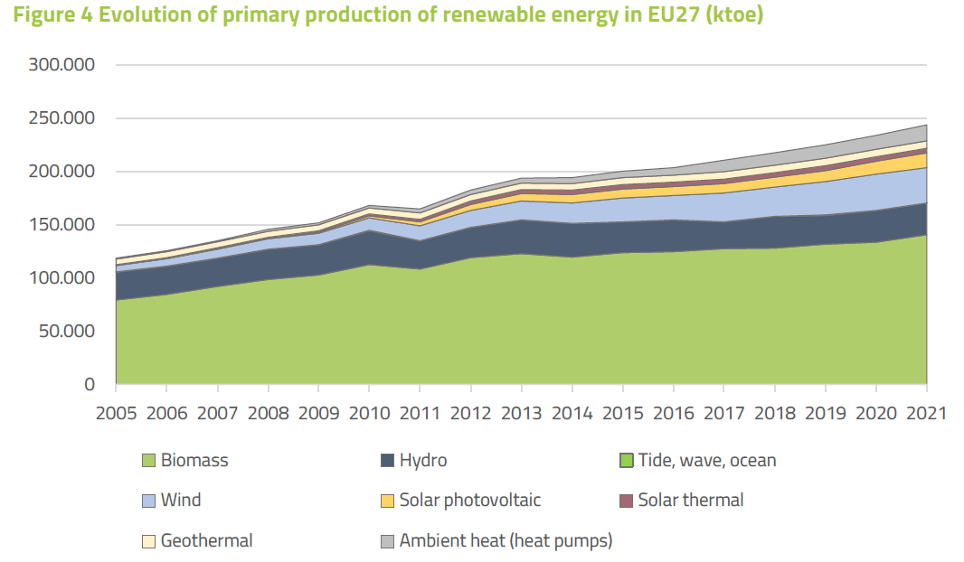
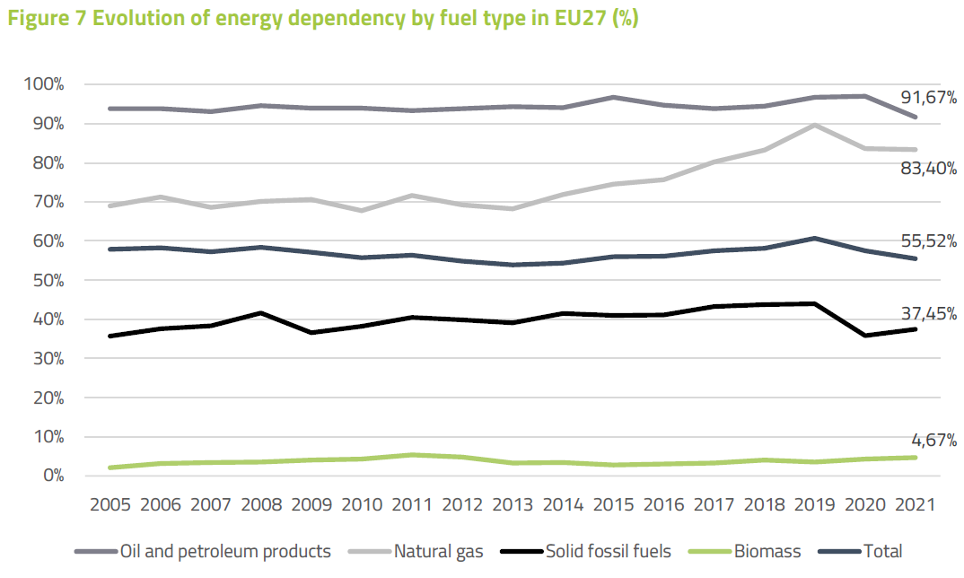
In 2021, the EU imported 55.5% of its energy consumption, which is almost 5% less than in 2019, when this indicator reached a historical high of 60.7%. One of the reasons is reduced demand due to restrictions due to the COVID-19 pandemic and the subsequent economic slowdown.
The most important fuels in the EU’s energy balance in 2021 were oil and oil products (32.4% of gross domestic consumption), as well as natural gas (23.9%), which together account for more than half of the EU’s energy. Both sources are highly dependent on imports, with gas having an energy dependency of 83.4%, while oil and petroleum products account for 91.6%. These indicators prove how much the EU depends on other countries.
In addition to energy use, oil is also an important commodity for the petrochemical industry and the production of fuel used in transport. The dependence of the European Union on the import of natural gas and oil has become a critical problem in the conditions of the war in Ukraine and the geopolitical crisis. These are risks to the security of member countries and the vulnerability of European consumers to supply disruptions and price fluctuations.
In contrast, biomass offers a sustainable alternative as an affordable local source of energy (import dependence is estimated at 4.7%), which means it can guarantee energy security. By using local wood, agricultural by-products and waste for energy, the EU can significantly reduce its dependence on fossil fuel imports. Biomass not only helps diversify sources, but also contributes to climate goals.
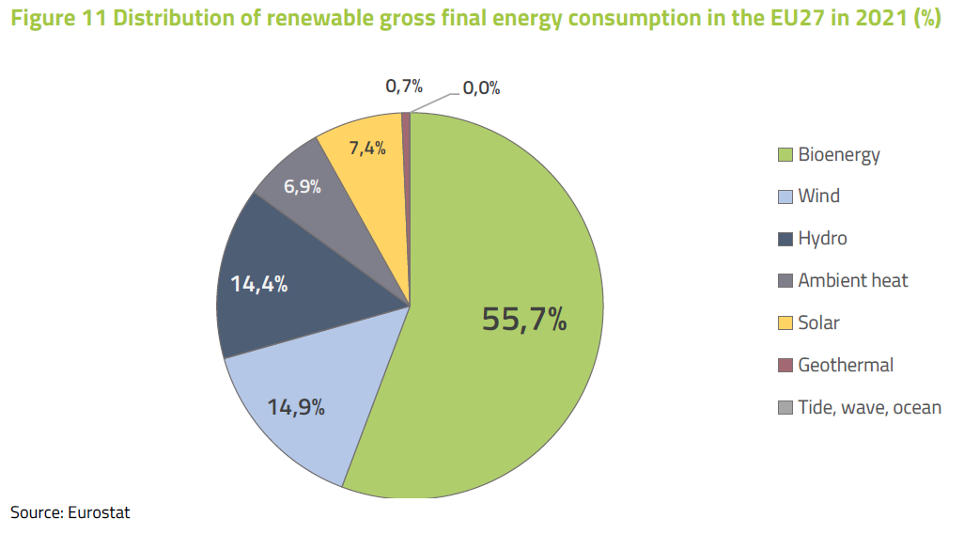
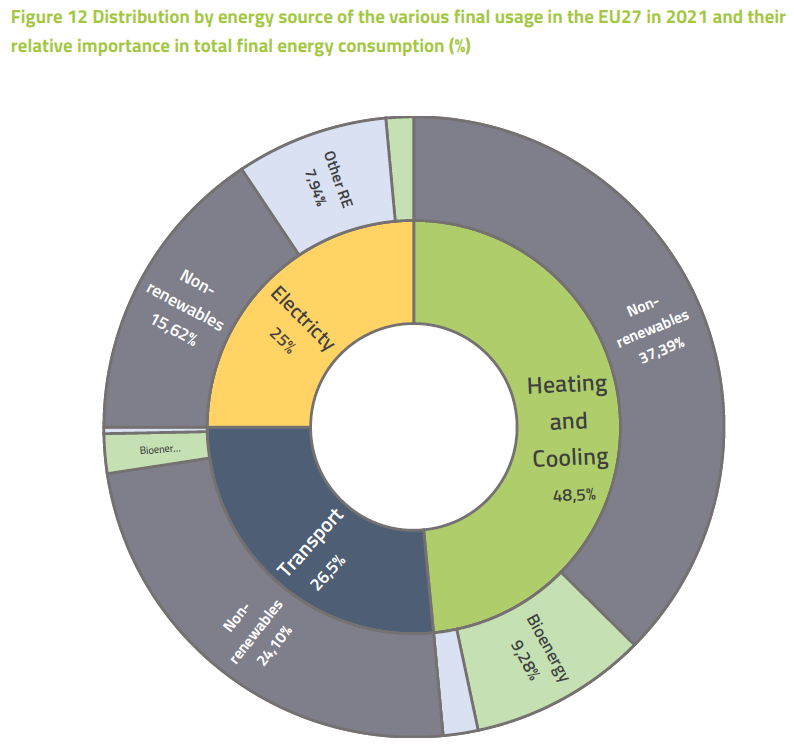
Energy is distributed between three sectors:
- heating and cooling (48.5%),
- transport (26.5%),
- electricity production (25%).
It is worth noting that the calculations of the share of RES in transport are carried out according to the EU methodology with the use of multipliers. Thus, renewable electricity exceeds its energy content by 4 times to the share of RES in transport for use in cars and 1.5 times for use in railway transport. Non-food renewable fuels used in transport have a factor of 1.2. This methodology artificially increases the contribution of renewable energy sources, in particular renewable electricity, to the achievement of transport goals, and also gives a distorted picture of the actual share of renewable energy sources in transport, which is mostly dominated by biofuels (over 90% without multipliers). These multipliers make the share of energy in the transport sector larger than it actually is compared to the electricity, heating and cooling sectors.
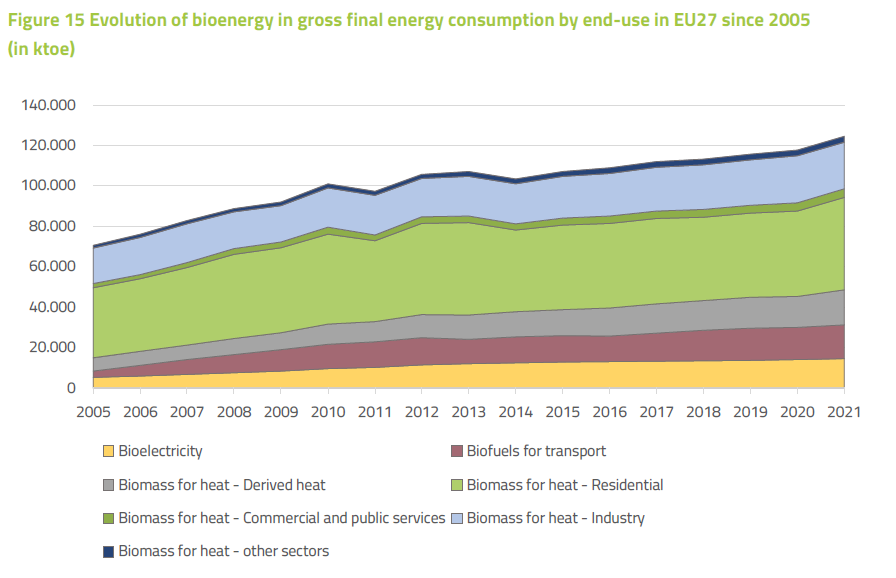
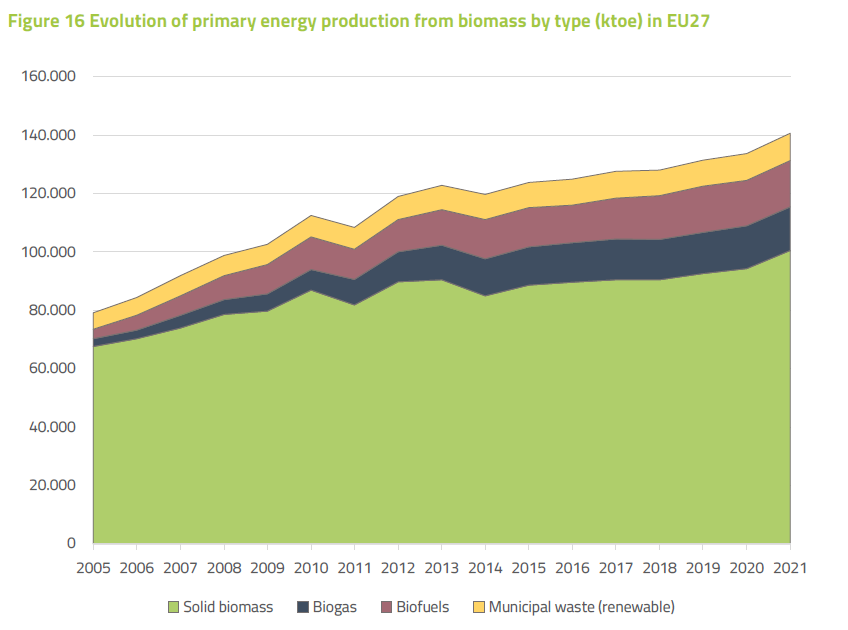
Solid biomass remains the main type of biomass consumed in the EU-27. It accounts for almost 70.5% of the total domestic gross consumption of biomass for energy production. The rest is covered by biogas (10%), liquid biofuels (12.8%) and energy from the organic part of household waste (6.6%).
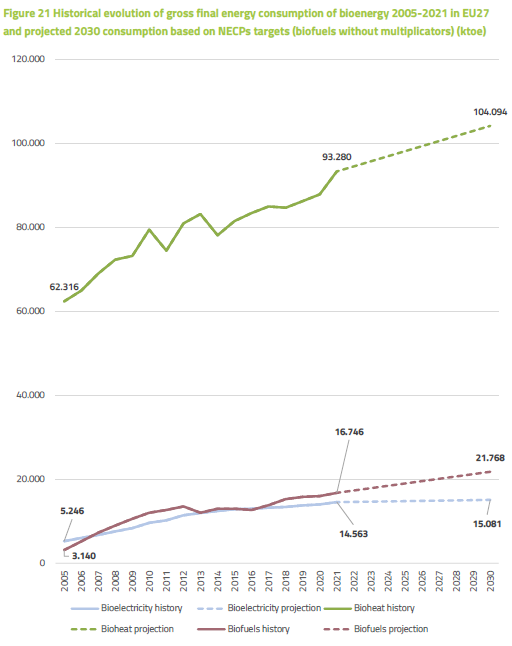
Bioenergy is also the largest renewable energy source in terms of direct and indirect employment, with 563,700 jobs in the solid biomass, biofuel, biogas and renewable municipal waste sectors. Because bioenergy is based on raw materials from agriculture and forestry, the sector is labor intensive compared to other renewable energy sources. In addition, bioenergy projects are mainly implemented in rural areas, which has a positive effect on the incomes of farmers and forest owners, as well as on local economic development.
In 2021, the total turnover of the bioenergy sector amounted to EUR 58.5 billion in the EU-27. The industry is growing steadily and rapidly with an increase in turnover from €25 billion in 2010 to approximately €38.5 billion in 2021 in the EU27. Unlike other industries, the COVID-19 pandemic has not reduced turnover as it has in other sectors, but growth rates have slowed.
The European Union continues to be a world leader in bioenergy; however, it is crucial that the right regulatory and market conditions work to ensure that the EU maintains industrial leadership, global competitiveness and know-how in the bioenergy sector.
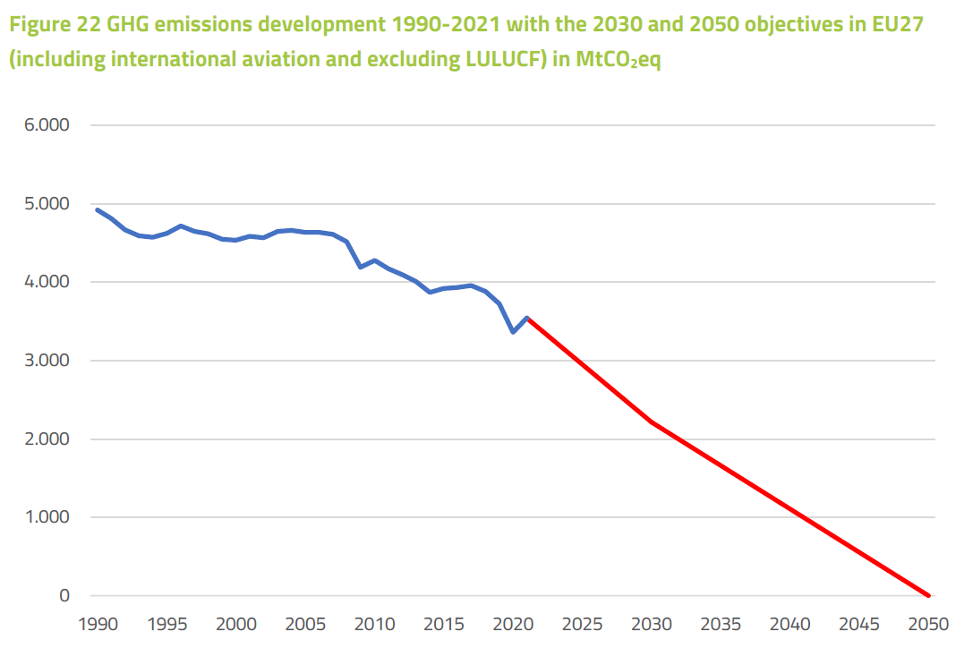
The EU is a world leader in the fight against climate change and a leader in reducing greenhouse gas emissions. Ambitious actions and commitments to climate neutrality by 2050 confirm this. EU GHG emissions fell by around 30% between 1990 and 2021 (the latest base year for which an official UNFCCC report is available). The main driving force for the long-term reduction of total greenhouse gas emissions is the improvement of energy efficiency and the increase of the share of renewable energy sources in the energy balance.
The latest diagram shows that even if greenhouse gas emissions in the EU will decrease, we will be able to achieve climate neutrality only if measures are strengthened.
The two biggest challenges to reducing emissions are population growth and GDP growth, as higher living standards correlate with increased consumption of resources and energy (which is still produced from fossil fuels).


